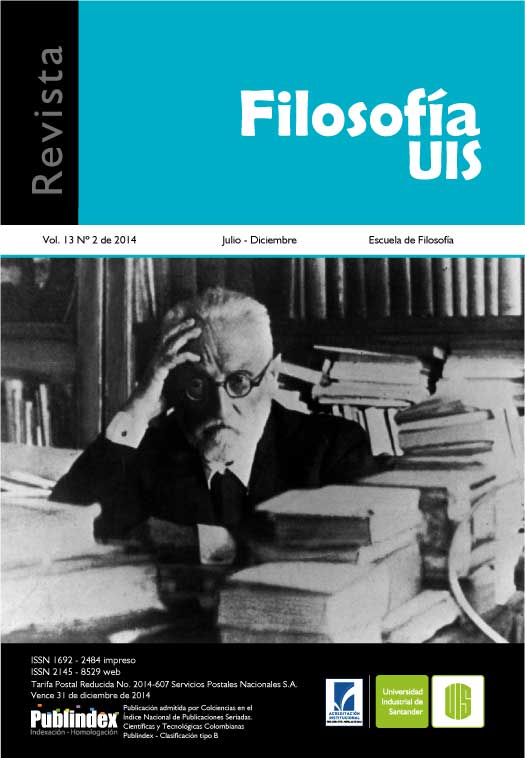Publicado 04-11-2014
Palabras clave
- memoria,
- tiempo,
- constitución,
- cumplimiento,
- distancia
Cómo citar
Derechos de autor 2015 Juan Carlos Rincón Acuña

Esta obra está bajo una licencia internacional Creative Commons Atribución 4.0.
Resumen
La memoria se concibe como un enlace fluido del objeto pasado con los demás objetos pasados hasta el instante vivido, en el cual se determina la conciencia del tiempo y la conciencia del ego. El análisis, parte del mundo como sustrato, donde se da la relación nóesis-nóema, para analizar con ello la estructura de la memoria y su relación con la conciencia interna del tiempo. Se recurre al acto de cumplimiento (die Erfüllung) y al proceso recursivo de retención (y por ende de protención) como momentos de la conciencia del tiempo, no de la conciencia que es objeto de ella.
Descargas
Citas
- Brough, J. B. (1975). “Husserl on Memory”. The Monist. 59(1). pp. 40-62.
- Grush, R. (2006). “How to, and how not to, bridge computational cognitive neuroscience and Husserlian Phenomenology of time consciousness”. Sythese. (153). pp. 417–450.
- Herrera, D. (1986). Escritos sobre Fenomenología. Bogotá: Universidad de Santo Tomás.
- Husserl, E. (1980). Phäntasie, Bildbewusstsein, Erinnerung. Zur Phänomenologie der anschaulichen Vergegenwartigungen. Texte aus dem Nachlass (1898-1925). The Hague, Netherlands: Martinus Nijhoff. [v.i. Phantasy, Image Consciousness, and Memory (1898-1925). Trad. Brough, J. 2005 ] (Citado Hua. XXIII).
- Husserl, E. (1973). Die Idee der Phänomenologie. Fünf Vorlesungen. (Citado Hua. II).
- Husserl, E. (1973). Ding und Raum. Vorlesungen 1907. The Hague, Netherlands: Martinus Nijhoff. [v.i. Thing and Space: Lectures of 1907. Trad. Rojcewicz, R. 2010] (Citado Hua. XVI).
- Husserl, E. (1969). Zur Phänomenologie des inneren Zeitbewusstesens (1893-1917). The Hague, Netherlands: Martinus Nijhoff. [v.i. On the Phenomenology of the Consciousness of Internal Time (1893-1917). Trad. Brough, J. 1991](Citado Hua. X).
- Husserl, E. (1966). Analysen zur passiven Synthesis. Aus Vorlesungs- und Forschungs manuskripten, 1918-1926. The Hague, Netherlands: Martinus Nijhoff. [v.i. Analyses Concerning Passive and Active Synthesis: Lectures on Transcendental Logic. Trad. Steinlock, A. 2001] (Citado Hua. XI).
- Husserl, E. (1936). Die Krisis der europäischen Wissenschaften und die transzendentale Phänomenologie. Eine Einleitung in die phänomenologische Philosophie. The Hague, Netherlands: Martinus Nijhoff. [v.i. The crisis of European sciences and transcendental philosophy. An introduction to phenomenology. Trad. Carr, D. 1970] (Citado Hua. VI).
- Husserl, E. (1929). Cartesianische Meditationen und Pariser Vorträge. Den Haag: Martinus Nijhoff. (citado como Hua. I).
- Husserl, E. (1913). Ideen zu einer reinen Phänomenologie und phänomenologischen Philosophie. The Hague, Netherlands: Martinus Nijhoff. [v. i. Ideas pertaining to a pure phenomenology and to a phenomenological philosophy. First book: general introduction to a pure phenomenology. Trad. Kersten, F. 1983] (Citado Hua. III).
- Reeder, H. P. (2011). La praxis fenomenológica de Husserl. Bogotá: San Pablo.
- Vargas Guillén, G. (2012). Fenomenología, formación y mundo de la vida. Problemas teóricos y metodológicos de la fenomenología. Saarbrücken: Editorial Académica Española.
- Walton, R. (2014). Husserl: La intencionalidad. Estratos del nóema. Buenos Aires: Grupo Poeisis.
